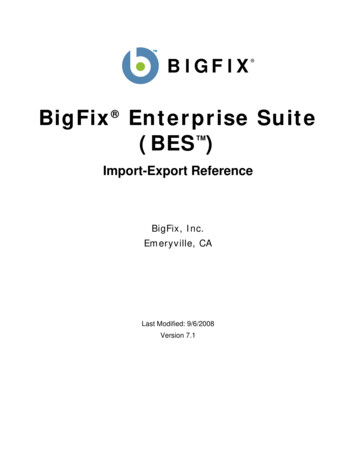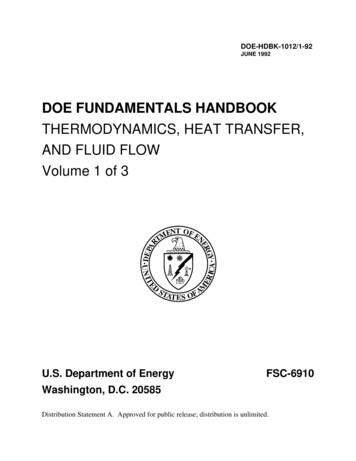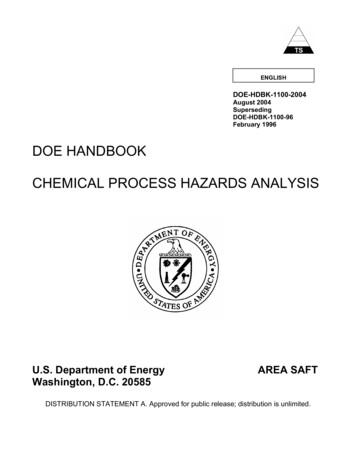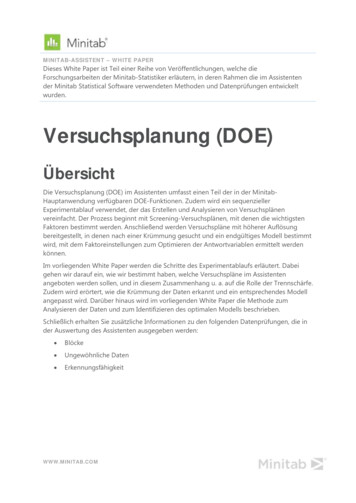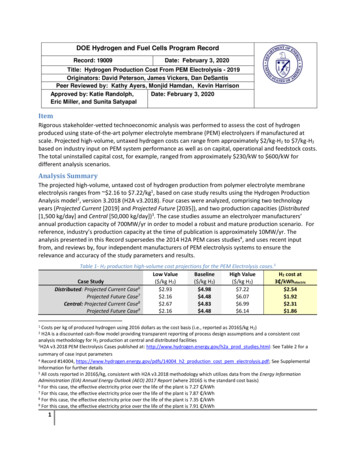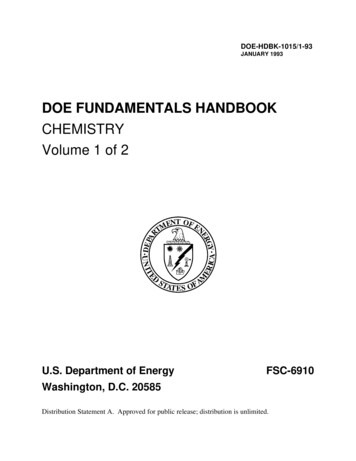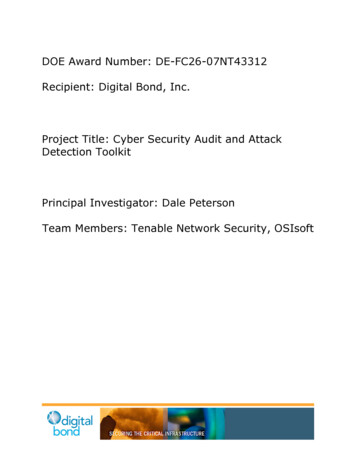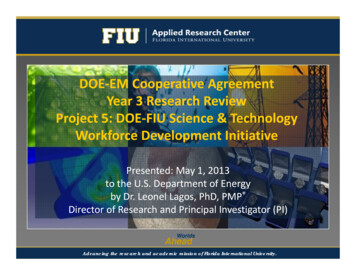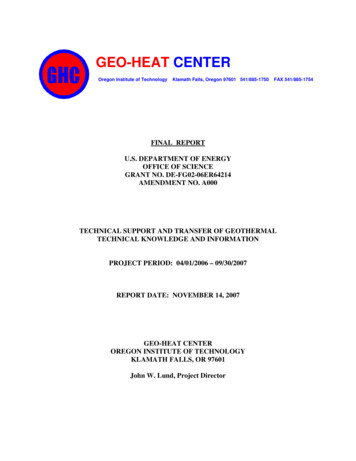
Transcription
GEO-HEAT CENTEROregon Institute of TechnologyKlamath Falls, Oregon 97601 541/885-1750FAX 541/885-1754FINAL REPORTU.S. DEPARTMENT OF ENERGYOFFICE OF SCIENCEGRANT NO. DE-FG02-06ER64214AMENDMENT NO. A000TECHNICAL SUPPORT AND TRANSFER OF GEOTHERMALTECHNICAL KNOWLEDGE AND INFORMATIONPROJECT PERIOD: 04/01/2006 – 09/30/2007REPORT DATE: NOVEMBER 14, 2007GEO-HEAT CENTEROREGON INSTITUTE OF TECHNOLOGYKLAMATH FALLS, OR 97601John W. Lund, Project Director
GEO-HEAT CENTERFINAL REPORTNovember 16, 2007TECHNICAL SUPPORT FOR DEVELOPERS, OPERATORS AND END-USERSThis final report for USDOE Office of Science Grant No. DE-FG02-06ER64214 titled“Technical Support and Transfer of Geothermal Technical Knowledge and Information,” coversa period of 18 months from April 1, 2006 to September 30, 2007. Six Quarterly Reports weresubmitted during this period which can be reviewed for more details on the accomplishments.The persons at the Geo-Heat Center (GHC) who were involved in carrying out the activities ofthis grants were: John W. Lund, GHC Director and Civil Engineer, Tonya “Toni” Boyd,Engineer, Gene Culver, Mechanical Engineer, Andrew Chiasson, Mechanical Engineer, andDebi Carr, Secretary.Technical Support SummaryThe GHC staff provided responses to 1442 technical support requests during the contract period(April 1, 2006 to September 30, 2007), which were six quarters under this contract. Our website,consisting of 1900 files, also contributes to our technical assistance activity. Downloaded fileswere 1,889,323 (3,448 per day) from our website, the total number of users was 1,365,258 (2,491per day), and the total number of hits were 6,008,500 (10,064 per day). Graphs of technicalassistance, users and downloaded files are attached at the end of this report, showing past trendsin light color and values for this grant in dark colors.These technical assistance requests/responses were from 48 states (except ND and WV), theDistrict of Columbia and Puerto Rico, and included 230 international contacts (16%) from thefollowing 56 countries: Australia, Bangladesh, Canada, Chile, China, Denmark, Djibouti, Egypt,Estonia, Ethiopia, Finland, France, Germany, Ghana, Greece, Hungary, Iceland, India, Indonesia,Iran, Italy, Jamaica, Japan, Kenya, Laos, Lithuania, Malaysia, Mexico, Monaco, Netherlands,Netherland Antilles, New Zealand, Norway, Pakistan, Peru, Poland, Romania, Russia, SaudiArabia, Slovakia, Slovenia, South Korea, Spain, St. Lucia, Sweden, Switzerland, Sudan, Taiwan,Turkey, Uganda, United Arab Emirates, United Kingdom, Viet Nam and Zambia. A total of 687contacts (48%) were by email of which 164 (11%) could not be identified as to location. Otherforms of communication were by phone: 436 (30%), actual visit: 308 (21%), and mail/fax: 11(1%). A breakdown of requests relative to applications is: General (501 – 35%), GHP (487 –34%), Resource/Wells (110 – 8%), Electric Power (69 – 5%), Space Heating/Cooling (74 – 5%),Resort/Spa (55 – 4%), Equipment 46 – 3%), Greenhouses (27 – 2%), Aquaculture (19 – 1%),Industrial (18 – 1%), District Energy (15 – 1%), Snow Melt (14 – 1%), and Regulation/Environmental (7 – 0.5%). Within the General category of requests, 363 (72%) fromprofessional people or organizations, 71 (14%) were from students, 53 (11%) for databaseinformation, and 8 (2%) from other categories.Of the total 289 inquiries/responses, 157 (54%) from individuals (including students), 77 (27%)were from private companies, 23 (8%) from organizations such as ASHRAE, NREL, GEA,1
GRC, etc., 17 (6%) from educational institutions, and 15 (5%) from government agencies(federal, state and local).Details of Major Technical Assistance ProjectsA number of technical assistance projects were highlighted in previous Quarterly Reports.Some of the more significant ones are listed below.Jeld-Wen Geothermal Investigation: Geo-Heat Center staff met with the engineers of the localdoor and window manufacturer concerning the possibility of finding geothermal hot water ontheir property near Upper Klamath Lake to provide space and process heat at their plant.Unfortunately, no known geothermal resource exists near their property. They then indicatedinterest in investing in the proposed deep well and high temperature power plant on campus.The proposal included constructing about a 4,000-foot pipeline from campus to their facility totransmit hot water/steam from the OIT well. In a second meeting, they presented us with a costestimate along with various tax incentives available to a private company for the electricitygeneration. Their proposal is under consideration by the OIT financial officer.Apartment Complex on Old Fort Road, Klamath Falls, OR: Toni Boyd investigated and loggeda well that is presently being used to provide space heating for three homes and six duplexes.The well appears to have caved-in near the bottom due to lack of casing for the bottom 200 feet,and thus does not provide enough heat during the coldest period to the buildings. After loggingthe wells before and after cleaning, it was suggested that a promoter pipe be installed in the wellalong with the downhole heat exchangers to increase the vertical fluid circulation and thusincrease the output of the well. This is presently being undertaken by the well driller and owner.Steamboat Springs, CO Pavement Snow Melting Project: John Lund visited Steamboat Springs,Colorado to follow up on his feasibility study presented to the City planners and ski areadevelopers for heating walkways at the ski area to melt snow. Temperature gradient holes werebeing drilled to determine if sufficient temperatures were available for heating the pavement.After making a presentation to interested parties, the size of the project was reduced to 100,000square feet from the original 200,000 square feet, and geothermal heat pumps were alsodiscussed as an alternative, if sufficient temperatures geothermal resources were not available.A revised feasibility study was prepared and submitted to the City (attached). At the same time,the Heart Springs Municipal Swimming Pool heating system was being upgraded. We offeredrecommendations for the pool heating systems with revisions to their design.Veterans Memorial Snow Melt System, Klamath Falls, OR: Toni Boyd and John Lund discussedthe design of a snow melt system for a veterans memorial to be constructed in Veterans Parkwith the local Air Base engineers. Toni Boyd designed a snow melt system pipe configurationand the Geo-Heat Center provided the community project with 600 feet of 5/8-inch PEX pipe leftover from another project.Cheese processing facility, Klamath Falls, OR. We met with Larry Holzgang, BusinessDevelopment Office of the Oregon Economic and Community Development Department along2
with James H. Renzas a California realtor (Location Management Services) to discuss thefeasibility of using geothermal energy in a cheese processing facility and if there was ageothermal potential on property adjacent to the Klamath Falls airport. We indicated that thepotential for a geothermal resource on the property was low, and instead suggest usinggeothermal heat pumps. We provided the realtor for his client with a recent study for the USDAFarm Bill on a geothermal dairy facility using geothermal heat pumps to indicate the potential ofusing this equipment and to apply for a renewable energy grant from USDA.Over the Horizon Back Scatter radar site, Christmas Valley, OR. We met with Trey Senn of theKlamath/Lake County Economic Development Association and representatives of a Californiafirm (TSS Consultants), interested in developing this abandoned site in Oregon and one justsouth of Klamath Falls in California as a site for solar power using solar photovoltaics.Numerous interested parties from Oregon and California such as country commissioners,economic development persons and state officials were also present. We indicated that wecould investigate the geothermal potential at the two sites, to be used in a cooling mode for theproject.Downhole Heat Exchanger Research: The Geo-Heat Center continued on-going applied researchand monitoring of PEX (cross-linked polyethylene plastic) downhole heat exchangers (DHE) bydesigning and installing the second known installation in Klamath Falls (and probably the world)in a geothermal well on Hillside Ave. The well provides both space heat and domestic hot waterfor two homes, and thus this is the first known PEX installation that provides hot water for twouses, as the first installation at another home in Klamath Falls was only used for space heating.Two PEX “u-loops” were installed in the well and manifolded together as shown in thephotograph below. Note that in the photograph, the PEX service DHE loops are the white plastictubes and the red tube is a single PEX slotted convection promoter and “access” tube fordownhole water-level and temperature measurements. A data logger was also installed on thesystem for recording water temperatures entering and exiting the PEX DHE. Temperatures arebeing collected at 15-minute intervals, and thus far, the performance has been excellent. During acold spell in early December of 2006, the air temperature dipped to near 0oF and the DHEprovided an average water temperature of about 168oF to both homes, which dropped to about158oF during a period of heavy domestic hot water use.In addition to the new PEX installation on Hillside Ave., the Geo-Heat Center is currentlyworking with two other home owners interested in installing a PEX DHE.3
Agri-Business Application: The Geo-Heat Center was contacted by a business owner in southernCalifornia about using geothermal energy in a unique application. The business currently raisespredator mites that are sold to large agricultural crop producers to feed on other mites that aredevastating to crops. The use of predator mites eliminates the need for toxic pesticides that havelimited use. The predator mites are best grown on bean crops, and require a constant 90oFgrowing environment in greenhouses. Thus, the business of incubating these predator mites isextremely energy intensive and cost-prohibitive, even in southern California. The Geo-HeatCenter staff, in cooperation with the Klamath County Economic Development Association metwith the business owners and explained the use and benefits of geothermal energy with tours anddiscussions. The business owners have completed an agreement to lease land and geothermalwater from a local successful geothermal greenhouse and aquaculture operation. The project isnow operational on the Liskey Ranch south of Klamath Falls and is using geothermal energyfrom wells on the property.Meeting with Chevron Energy Solutions, Klamath Falls, OR: Geo-Heat Center staff met withDan Hand, Project Development Manger for geothermal direct-use project with Chevron EnergySolutions. He was interested in developing projects in the west and sought our recommendationof sites that had high potential. We discussed numerous locations in the western states andindicated strengths and weaknesses of potential project development. He was especiallyinterested in reports that we had for the Mt. Grant Hospital in Hawthorne, NV and the OnionDehydration Plant proposed for eastern Oregon.Parker River National Wildlife Refuge, Newburyport, MA: Decision-makers at the U.S. Fish andWildlife Services were referred to the Geo-Heat Center by Oak Ridge National Laboratory. Thisfacility has a geothermal heat pump system supplied by two standing column wells. Since itscompletion in 2003, the system at Parker River has experienced a number of problems andequipment failures and has resulted in accusations and “finger-pointing”. During the first winterof operation, the system was occasionally unable to meet heating loads. Well water temperatureswere measured to be as low as 36 F, and heat pumps were shutting down on freeze protection.The main cause of problems has been identified as poor quality of water supplied by the wells(high chloride concentration due to proximity to the Atlantic Ocean), which has resulted incorrosion/erosion of flow control valves. The maintenance staff was so fed up with the systemthat scrapping the whole thing and switching to conventional heating and cooling was beingconsidered. Through numerous email and telephone correspondences with decision makers at theU.S. Fish and Wildlife Services, the Geo-Heat Center restored confidence in preserving thegeothermal system, since such a system was the original intent of the building owners. Based onsome analyses by the Geo-Heat Center, the building owners are currently pursuing convertingthe standing column wells to a closed-loop system.Deep Well, Oregon Institute of Technology, Klamath Falls, OR: The administration on campusrequested assistance in evaluating the potential to develop geothermal electric power on campususing the geothermal resource that is presently being utilized to heat the campus. We reviewedliterature that suggested a deep and high temperature (above 150oC or 300oF) resource mightexist below 3,000 feet based on geochemistry signatures. We prepared several position papers(attached) evaluating the potential and risks of drilling a deep well (up to 5000 feet) and then4
generating electricity with a 1.2 MWe plant. This would allow the campus to be completelyenergy independent. We then suggested several consultants (geologists, drilling engineer andeconomics) to make presentations to the administration, and to prepare in-depth reports on thepotential and feasibility of this project, to be presented to potential investors.Klamath Union High School, Klamath Falls, OR: At the request of the superintendent of theCity School District, we prepared a letter report analyzing the potential for geothermaldevelopment and use at two sites being considered for a new high school campus. Wesubsequently met with the architect to discuss the potential at the northern (Linton) site near thePelican Theater. Since no geothermal resource probably exists
with James H. Renzas a California realtor (Location Management Services) to discuss the feasibility of using geothermal energy in a cheese processing facility and if there was a geothermal potential on property adjacent to the Klamath Falls airport. We indicated that the potential for a geothermal resource on the property was low, and instead suggest using geothermal heat pumps. We provided .
